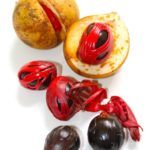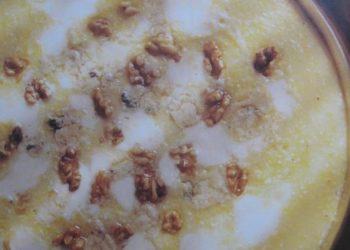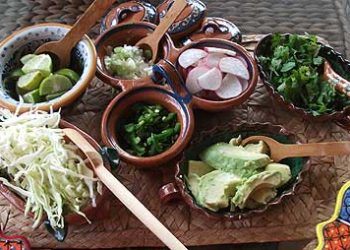A single male tree can fertilize up to twenty trees, with ten considered ideal by commercial producers. Since nutmeg trees do not reveal their sex until they are about seven years old, this can prove a problem, especially in areas where the trees have self-sown. A good deal of hacking down of obsolete males must take place in most nutmeg orchards.
The female trees are slow to mature, not reaching their full bearing capacity until they are from fifteen to thirty years old. They reward their growers’ patience, however, and generally offer up their fragrant fruit until well after their tenders themselves have been planted in the ground.
The nutmeg tree gives us two spices, mace as well as nutmeg. The trees grow to heights of twenty feet or more, and beautiful yellow-green fruit about the size of apricots, covered with a peach-like down, hang throughout the branches, with as many as 2000 fruit per tree each year. The fruit will often split open before harvest, dramatically revealing a bright scarlet filigree membrane, known as the aril, that surrounds the nutmeg kernel. This red net enclosure is mace. It is separated, dried, ground, and used almost exclusively in cooking.
The nutmeg kernel has a broader range of uses. The extract finds its way into medicines, pharmaceuticals, cosmetics and perfumes, soft drinks, and commercially prepared foods. Those of the highest quality–they demonstrate their quality by sinking to the bottom of vast vats of water–are sold as whole spice.
In the 1960s, when young people were experimenting with everything from LSD to banana peels as a means of altering consciousness, rumors of nutmeg as a natural hallucinogen were common.
Americans are most familiar with ground nutmeg and tend to use it timidly, in spite of the fact that our British ancestors, who profoundly influenced our culinary habits, used it in large amounts. Whole spice was preferred to ground, and many a well-dressed Brit carried a pocket grater and a nutmeg kernel. Recipes from the 17th and 18th centuries reveal dishes that called for half a dozen or more whole nutmegs. In the 1960s, when young people were experimenting with everything from LSD to banana peels as a means of altering consciousness, rumors of nutmeg as a natural hallucinogen were common. I don’t know of anyone who ate it in such quantities as to confirm the story and I have found no confirmation in any of the nutmeg literature I have read.
Nutmeg is most familiar in baked sweets, especially many of those traditional around the holidays. It is also a common ingredient in bechamel sauce, broccoli, mushroom, and pumpkin soups, and in a variety of Creole dishes. I like it when it plays a more dominant role in a dish, when it is the featured flavor, as in simple pasta dish, lasagne noodles with nutmeg and cheese. There is something festive and comforting about its flavor, and I love it at the holidays, when, let’s face it, we need all the comfort we can find.






